
Turning Strangers into Students® (and Advocates) – A Study on Inbound Marketing and Recruitment in Higher Education (Part 3 of 3)
By Dr. Jean Norris, Managing Partner, Norton|Norris, Inc. and Linda Ganster, Managing Partner, The Grandview Group
In the third and final part of our study, “Turning Strangers into Students® (and Advocates),” we’d like to return to the traditional sales funnel that served as a catalyst for this entire study. In career schools, the stages of the admissions funnel typically begin with an inquiry/lead that converts to a set appointment that hopefully will actually show up on campus or a phone appointment. From here, the hope is the prospective student applies and eventually starts school (and the upcoming start is always preferred).
We’ll begin by sharing typical results based on the traditional funnel; then take a look at funnel activities from the user experience; as well as consider how the funnel might fall short in dealing with critical compliance and student retention aspects. Finally, we’ll suggest that, even in its most idealized form, the funnel is still missing a critical piece. If we haven’t already convinced you of the need to move beyond the funnel, we hope this further examination will do the trick.
We’ll also take the same kind of look at our proposed replacement model, Turning Strangers into Students® (and Advocates), as well as discuss the impact of our research on that model. We’ll wrap up with a look at the future direction of our research to keep the conversation going.
Taking the “Fun” out of the funnel
In Part 1 of this study, we looked at the traditional sales funnel used by many career colleges. Clearly, loss at each stage is inherent in the concept of the funnel.
Image 1. Traditional Admissions Funnel
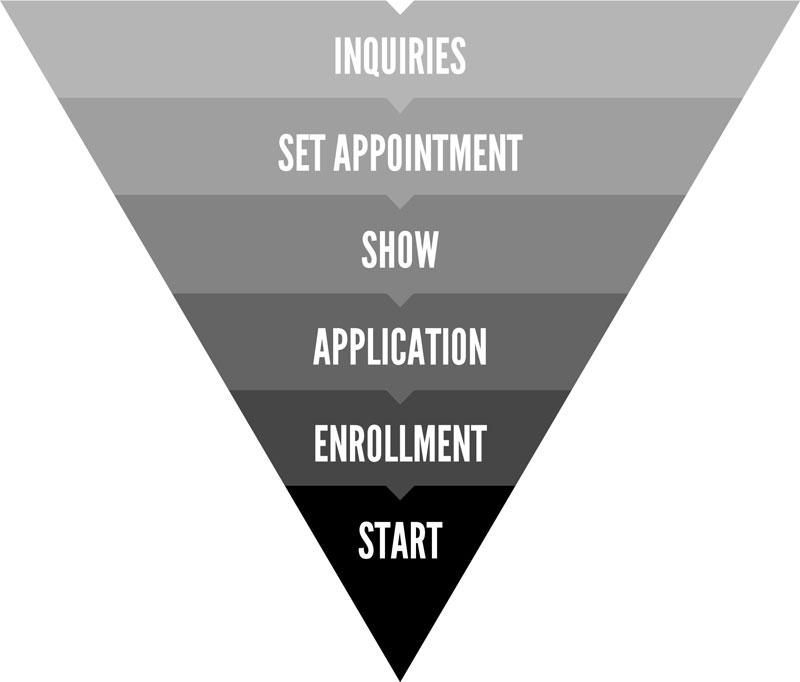
Now, let’s apply some representative numbers to the funnel to show the degree of loss.
Image 2: Typical Conversion Metrics
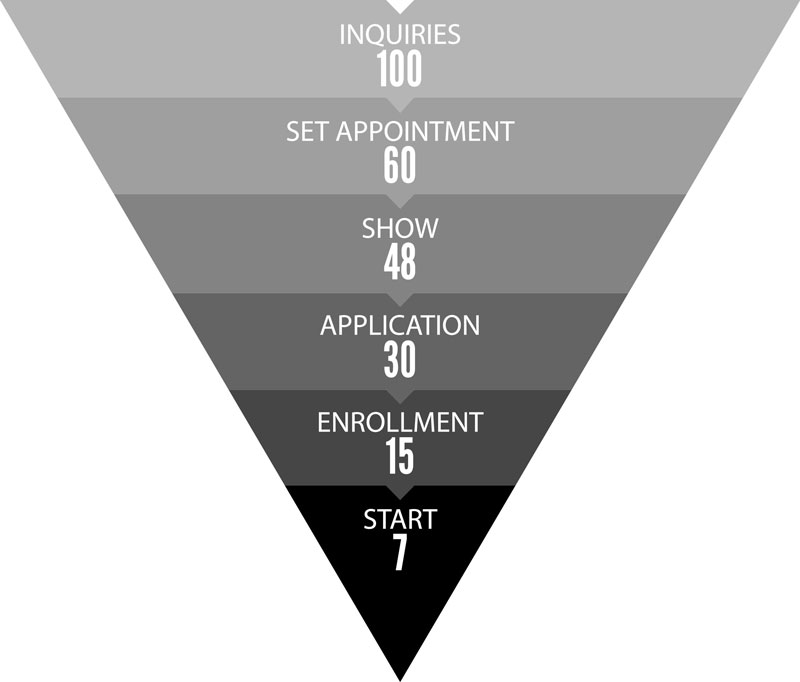
Even if your numbers differ slightly, relying on the funnel accepts huge attrition as a foundational assumption with a failure rate of 93 percent. While your admissions team is busily making phone calls, texting, leaving messages, sending emails and occasionally meeting with students, the majority of inquiries don’t respond. Being busy doesn’t equate to being effective and in fact, it appears these methods of outreach often alienate prospects, contributing to their disengagement. Perhaps it is the assumption of a 93 percent failure rate as the norm that is most deserving of the attention of our schools. Is there a way to challenge that assumption? (Spoiler alert: we think there is; keep reading.)
And what does this funnel activity look like from the viewpoint of a prospective student? Though there is tremendous variation in the career school student demographic, we think you will recognize our prototypical student; we’ll call her Stephanie. Perhaps you can empathize with her experience within the funnel.
Stephanie works a split shift as a waitress so that she can be home when her two kids get off the bus from school. She helps with homework and fixes dinner before turning them over to the babysitter and heading back to work the late shift. Stephanie gets home about 2 a.m., in time to grab a couple of hours of sleep, before getting up to get the kids breakfast and out the door for school. As a result of this grueling schedule, Stephanie is always exhausted, and she fears that this schedule is not sustainable. On top of the schedule stress, Stephanie is always worried about money. Her ex-husband is pretty good with child support, but he is often late and sometimes misses weeks. And, childcare is not cheap!
Most of the time, Stephanie does not have a chance to think further ahead than the next day, but one Sunday afternoon while the kids are with their father, she has a few precious hours to herself. She decides to get online to look for a new job, one that pays better and doesn’t require late nights. An hour into the search, she is discouraged and more hopeless than before. There just doesn’t seem to be a way out of the box she finds herself in. At that moment, her eye is caught by an ad that promises a better life through a career as a medical assistant. Thinking, “What do I have to lose?” Stephanie clicks on the ad.
Unbeknownst to Stephanie, that click sends her contact information to five schools. Those schools know that studies have shown that making initial contact within one minute of lead generation increases the chance of success by 400 percent, and that closing a prospect can take 6 or more contacts1. Consequently, Stephanie immediately receives emails from all five schools, each promising contact soon. She clicks through the emails, but they all seem to include a similar sales pitch, and she begins to fear that she has started something that she may not be able to stop. Then, the phone rings, and because the number that pops up on her phone appears to be local, Stephanie picks up. She is disconcerted to hear an enthusiastic stranger congratulate her on her interest in becoming a medical assistant. She feels cornered by the push toward setting an appointment to come to campus and agrees to a time the very next day, largely just to get off the phone and have time to think.
And so the onslaught begins – the emails and phone calls seem to come non-stop. Stephanie was already overwhelmed and uncertain, and this barrage only adds stress to her situation. To lessen her anxiety, Stephanie retreats back to her known world, one that is exhausting and insecure, but at least she knows how it works. The set appointment time comes and goes, and Stephanie is a no-show.
Of course, the admission representatives reaching out to Stephanie are just doing their jobs. However, take a moment to think how this model defines success and incents behaviors. Admission representatives are monitored and rewarded for pushing people through the funnel without considering the most important aspect: Does this model align with consumer needs and expectations? And what are the inherent risks of mandating activities that don’t produce the desired results? Well, we’ve seen enough headlines to understand that some admission representatives choose tactics that could affect compliance standards.
But on the bright side, those seven students that come out of the bottom of the funnel as starts count as success, right? Or is that dependent on one’s perspective? Though this is a key outcome of admission efforts, it falls short of global goals mandated by school management, accreditors, policy-makers, and the community-stakeholders who are much more interested in graduation rates and student outcomes than simply in starts. Just consider the financial consequences of failure to make good on educational opportunities. The ensuing costs are a collective loss to the student, their family, the school and society.
When considering the full student lifecycle, how many starts will actually make it to graduation from the original 100 inquiries (or the 7 that started school)? It is interesting that many in admissions are not sure on graduation rate nor do they take ownership for the outcome.
Image 3: Traditional Funnel through Graduation
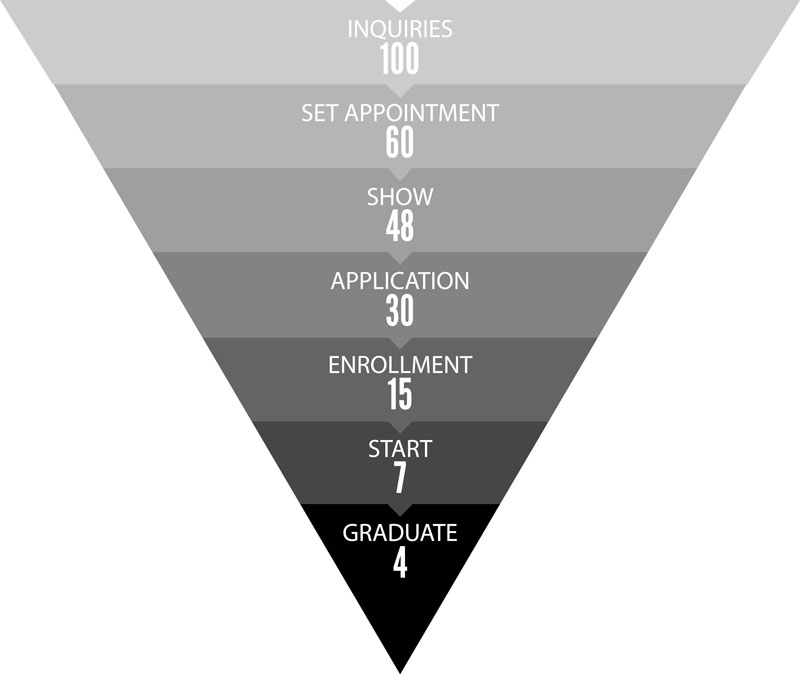
Research suggests that initial college “fit” is a key element in student retention and positive outcomes. According to a recent study conducted by the National Bureau of Economic Research (2015)2, “Such evidence matters because of the need to explain recent negative trends in U.S. college completion rates. Completion rates among college enrollers are lower now than in the 1970s, due in part to low completion rates of students from lower socioeconomic backgrounds.”
The authors go on to say, “We cannot rule out another margin of impact, namely the importance of unobserved college match quality. If missing these thresholds pushes students away from their desired college and to another college of similar observed quality, there may still be graduation impacts. If, for example, the desired college is closer to home or less expensive than the alternative, this may decrease completion rates.” This research is especially important as political pressure increases for free community college, a solution that may increase enrollments but not graduation rates. In fact, free college in the absence of proper fit may create more harm than good. A decision to attend the least expensive option may have long-term implications if the student drops out and decides not to pursue an education based on a poor experience.
Our research with high school counselors further supports the importance of fit. Focus group research showed the majority of school counselors expressed dissatisfaction with the lack of priority that both public and private school admission representatives give to the fit of the student.3 Participants stated there was an emphasis on the quantity of applications and enrollments over concern for proper student and programmatic fit.
Counselors further stated they see a gap in the knowledge base of college admission representatives in understanding their students especially in the areas of demographics, the alignment of needs to college, students’ lack of thoughtful planning, and an understanding of what it takes to be successful in college.
One could argue this is the job of the high school guidance office, however counselors are already overwhelmed with current caseloads representing a 350-400: 1 student to counselor ratio. Beyond the issue of volume is that of scheduling priorities. A majority of counselors’ time is spent on academic counseling (grades, schedules and course selection), as well as dealing with student issues and staff meetings. Only 20 percent of their time is devoted to college counseling and much of this is limited to helping students fill out applications, reviewing college essays and writing letters of recommendation.
By now, it should be obvious the traditional admissions funnel has run its course. But, does the Turning Strangers into Students® (and Advocates) model fare any better when looked at under the same lens? Let’s take a look.
Inbound marketing and recruitment model
As mentioned throughout this study, other industries have also discovered the demise of the funnel model largely due to changes in consumer behavior and access to technology in decision-making. The results above coupled with this new reality shape the impetus for exploring a new model – one that we call, Turning Strangers into Students® (and Advocates)
Image 4 – Turning Strangers to Students® (and Advocates) Model
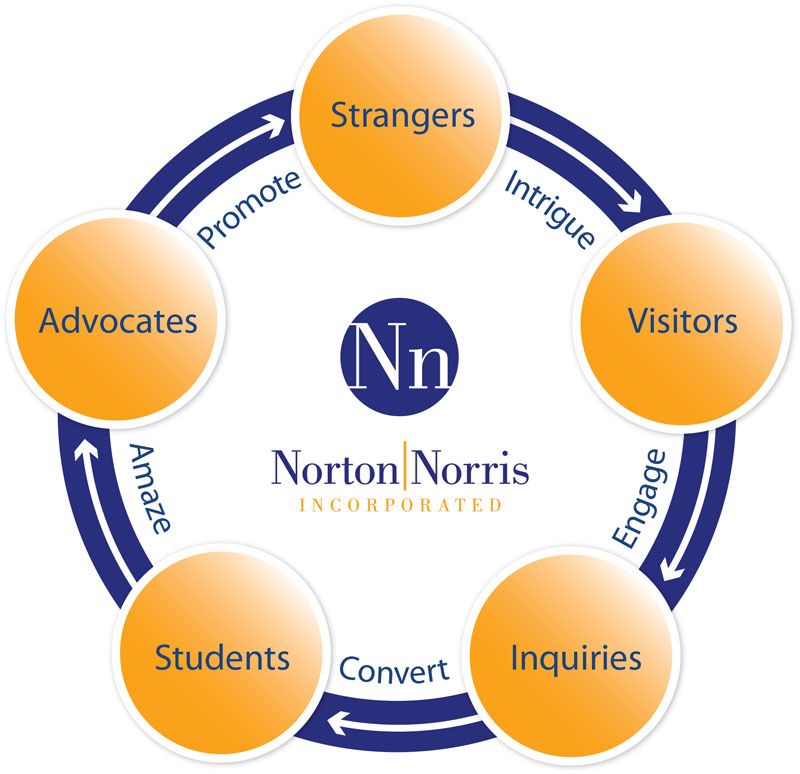
In this circular model, a prospective student is intrigued enough to engage with your school in the first place. The conversion of inquiries into students is based on finding the proper fit and a united team to support the student to graduation. This experience inspires a student who has meaningful student outcomes and shows their appreciation by becoming an advocate and promoter of your school.
Though more research is still necessary, early indications show implementation of the model through the use of an automated admissions service (My Guidance Coach®) has a positive impact on prospect engagement and conversion. Let’s examine each hypothesis statement to report on new data collected since Part 2 of this study.
H1: The Strangers to Students Model is effective in improving student engagement.
- 37 percent of MGC users came into one school from their MGC Web banner and had never inquired to the college through another avenue. This represents a 17 percent increase in organic Web inquiries (See Intrigue/Engage stages of new model).
- Two colleges saw an increase in MGC activity over the holiday season when admission offices were closed or had decreased hours.
- A multi-campus school saw a 75 percent increase in unique users who entered MGC and completed up to the “My Plan” (final) stage at one of their locations in a three-week period.
- Of those who “raised their hands” (indicating they wanted to connect with an admissions representative), 86 percent of them went through the entire coaching process the same day they signed into the system.
- No new data to report but earlier research shows higher conversion of the prospects that go through MGC first.
- A campus reported 3 additional starts generated via MGC during a month-long period (timeframe between Part 2 and Part 3 of our study). For this school, this equates to $36,000 in additional revenue.
- 37 percent of MGC users were generated as new, exclusive inquiries/leads and did not cannibalize other organic Web inquiries. When applying the average cost for Google adwords inquiries/leads, this equates to a $6,500 savings.
- Given all prospective students in MGC are pushed information and resources from the system that have been approved by the administrator, this hypothesis is confirmed.
- Prospective student engagement by viewing the resources is of concern however. Only 12 percent of the resources offered to the student for viewing were opened.
- High school counselors indicated a desire to have assistance from college admission representatives in coaching students. They did state they felt the representatives need more training on helping students find the right fit and how to prepare for college, etc.
- Looked at the experiences of schools and admission representatives in deploying My Guidance Coach®
- Collected quantitative data from the beta test schools
- Analyzed data collected within the My Guidance Coach® software
- Secured input from students regarding the software
- Supplemented data with qualitative research with school admissions administration and with admissions representatives.
- Collected information from high school counseling professionals
- H1: The Strangers to Students Model® is effective in improving student engagement, when it is used to enrich and enhance the student’s experience through pre-enrollment advising.
- H2: Automation of a prescribed coaching process is desirable for prospective students once the prospective student has expressed initial interest.
- H3: Automation of a prescribed coaching pre-enrollment advising process is desirable for admission professionals.
- H4: Automation of a prescribed coaching pre-enrollment advising process positively impacts ROI.
- H5: Automation can improve accuracy of information provided to prospective students, thereby ameliorating compliance risks.
- H6: Admission professionals desire enhanced training and development opportunities to further their careers and to enhance their ability to coach students for fit.
Next, we will complete the qualitative research with admissions representatives with the post-beta survey. We had planned to complete that step prior to this article, but admissions representatives at the beta schools have not yet had enough time with the program to have had prospective students progress through the full model. School events like new starts, changes to core systems, and new software rollouts have made admissions rep immersion into MGC slower than anticipated.
We’ll also continue our research with high school counselors. Our initial focus group with counselors indicated enthusiasm for a model and tool that will help vocational-track students assess their fit for programs and schools. Further research will dig into how benefits can contribute to enhanced collaboration between high school counselors and college admissions representatives can expand skill sets to expand their role in serving students.
We’ll also continue our work with prospective students comparing the experiences of those who have used MGC versus those who have experienced the traditional funnel in order to further understand how to best help students on their own terms.
Another aspect is to expand our research with admissions representatives with a goal of understanding how to enhance their professional development, knowledge, skills and experiences to serve students in an expanded, coaching role.
Thank you for accompanying us on this journey to understand the changing world of admissions. Our path has not been the straight line we envisioned and we have adapted as we learned. We do remain unshaken in our core conviction however – there is a better way to reach and graduate more students while improving student outcomes. We welcome your input and look forward to sharing the results of the entire study this spring!
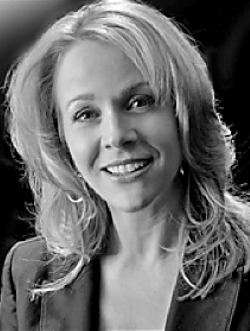
DR. JEAN NORRIS , is one of the leading advocates for the Admissions profession. In her 28-year career, she has served in the role of admission counselor, dean of admissions, faculty member, vice president of marketing, vice president of enrollment management, and vice president of organizational development at private colleges and universities across the U.S. Currently, Jean is a managing partner at Norton Norris, Inc., a Chicago-based marketing/consulting/training firm focused exclusively in the higher education sector.
Jean is the visionary behind the patent-pending software, My Guidance Coach® (MGC), which is an extension of the proven EnrollMatch® admissions training program. Thousands of admission professionals have already realized the impact of the EM system and the automation of key components was a natural next step to meet the needs of compliance and today’s student.
Dr. Norris earned a Doctor of Education Degree in Organizational Leadership, a MA in Communication and Training and a BA in Management. Jean is also a Licensed Master Neurolinguistic Programming (NLP™) Practitioner.
Contact Information: Dr. Jean Norris // Managing Partner // Norton|Norris, Inc. // 55 E. Jackson Blvd., Suite 950 Chicago, IL 60604 // 312-262-7400 // Jean@nortonnorris.com

LINDA GANSTER, has three decades of experience in higher education product development with companies like Pearson, McGraw-Hill and Cengage Learning. As Editor in Chief at Cengage, she managed the $200M behavioral, biological and earth sciences editorial group.
Currently, Linda is a Managing Partner at The Grandview Group, an innovative educational technology company with a passion for ideation, validation and execution. GVG’s clients include colleges and schools, publishers, associations, and large and small companies.
Contact Information: Linda Ganster // Managing Partner // The Grandview Group // 2150 Country Club Dr. #12 Mesa, AZ 85210 // 650-208-7045 // lganster@thegrandviewgroup.com
References
1. “(The) Ultimate Contact Strategy: How to Use Phone and Email Contact for Contact and Conversion Success.” Velocify Whitepapers and EBooks Library. Velocify.com. Web. 8 Jan. 2016.
2. College Access, Initial College Choice and Degree Completion (2015). National Bureau of Economic Research. © 2015 by Joshua Goodman, Michael Hurwitz, and Jonathan Smith. All rights reserved.
3. BenMessaoud, F. & Gormley, S. School Counselor Focus Group. December 21, 2015. Raw data. Chicago, IL.
H2: Automation of a prescribed coaching process is desirable for prospective students.
H3: Automation of a prescribed coaching process is desirable for admission professionals.
H4: Automation of a prescribed coaching process positively impacts ROI.
H5: Automation can improve accuracy of information provided to prospective students.
H6: Admission professionals desire enhanced training and development opportunities.
Let’s now take a look at what Stephanie, our sample prospective student, may experience within this new model. Let’s begin at the “Intrigue” stage just prior to clicking on that medical assistant ad she chose earlier.
Stephanie spends time reading about what medical assistants do and which schools offer programs in here area. She even watches a few videos and gets more excited as she can envision herself wearing scrubs and helping patients in a doctor’s office. There are several links that offer the promise of more information but require her to fill out more information than she’s comfortable with offering at this point. One school has a chat function and she engages with someone for a few minutes but is quickly turned off when she feels pressured to schedule an appointment. She quickly fills out one of the forms to at least get the ball rolling and almost instantaneously she receives emails, a text and what’s this? Someone is actually calling her? She is just not ready for that.
But wait! Here is a school that stands out by offering her a link to a coaching service to help her decide on program fit and if college is really for her. That sounds intriguing – and safe. She receives a link to My Guidance Coach® (MGC), a tool that she can work through in her own time – a tool that puts Stephanie’s needs, goals, and life circumstances at its center. Stephanie bookmarks the link and logs off, making a note to herself to put in a few minutes on her new project each night after work. She is still not sure that she can or should pursue college, but there is a glimmer of hope in her life that was not there when she sat down at her computer.
Over the course of the next week, Stephanie spends a few minutes after her shift using MGC to work through her own thoughts and to learn what it really means to be a medical assistant. She gets access to the information it takes to put her in control of the planning process, increasing her confidence and sense of empowerment. When the calls and emails from the other schools come in, she pushes back; she is not interested in letting others tell her what is best for her. But, when the admissions rep for the school that helped her take control calls to ask how she can help, Stephanie is prepared with questions that matter to her. They mutually agree on a time to get together to talk further. And when the time comes, Stephanie shows up, ready to be a partner in her own education.
MGC’s success in keeping students engaged post-inquiry, leads us to propose a new service category to support admissions. MGC is not intended as a lead generator (although results show it certainly brings in new inquiries) or a CRM. It is, primarily, a “pre-show” tool, one that helps maintain a prospect’s interest, motivation and commitment while remaining constructively involved in a process that enhances the value of the in-person “show.”
Image 5 – Main Impact of My Guidance Coach® (MGC)
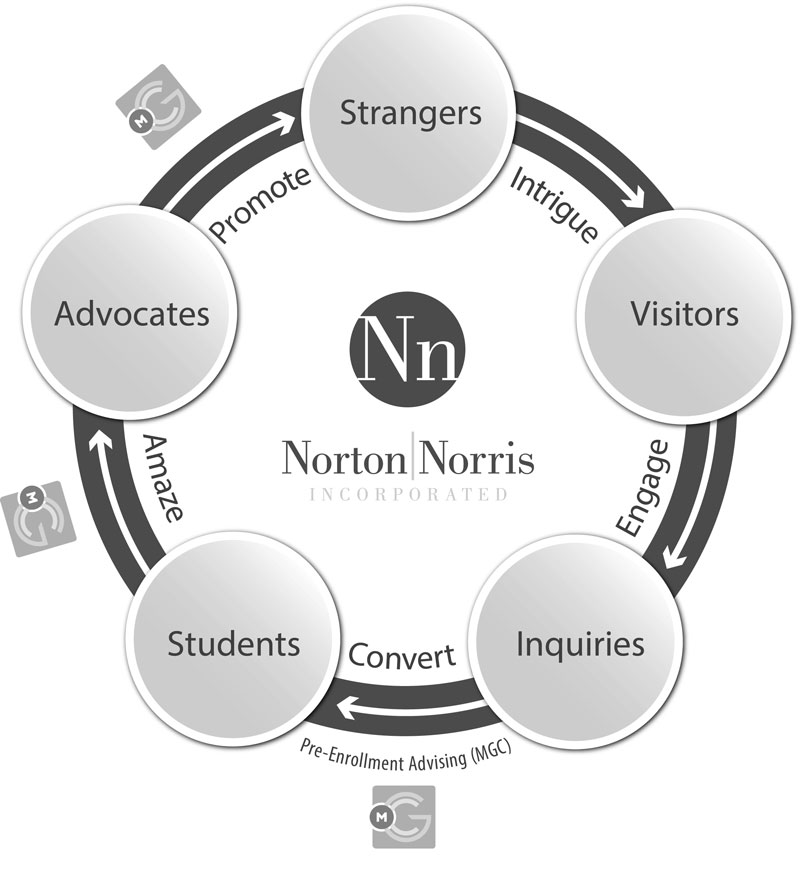
The benefits of the Turning Strangers into Students® (and Advocates) extends beyond the “show.? Using MGC, schools can ensure that all prospective students have access to the same, vetted (and compliant) information. Emphasizing the importance of pre-enrollment advising changes the role of an admissions rep from sales person to a coach, a shift that can provide a variety of benefits including increased professionalism, job satisfaction and improved compliance.
Lastly, because Stephanie is an educated consumer of her school’s product, she knows that the program and the school are a good fit for her, increasing the odds that she will persevere to graduation. In addition, all of the information that Stephanie entered in MGC about her life and her hopes will follow her throughout her school career, accessible to everyone at the school with an interest in helping her achieve her goals. When she goes to talk to financial aid, work with academic advising, engage with faculty and even begin her career search, everyone will know Stephanie in a way that will help them better understand and assist her.
Further inquiry
As support and research results build for this new model, opportunities to refine and expand our research focus have emerged. To date we have:
Based on our findings, we have made the following decisions with respect to our continued efforts in offering possible solutions for the sector.
First, we will further refine our hypotheses to hone in on the value of MGC as a pre-enrollment and compliance tool. The revised hypotheses are:



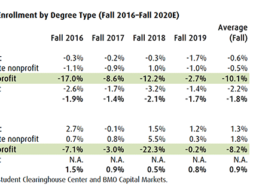



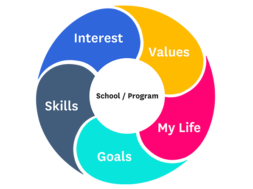

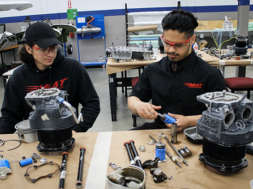
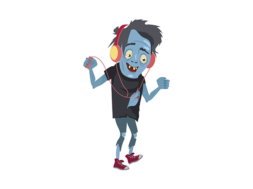
Comment(1)